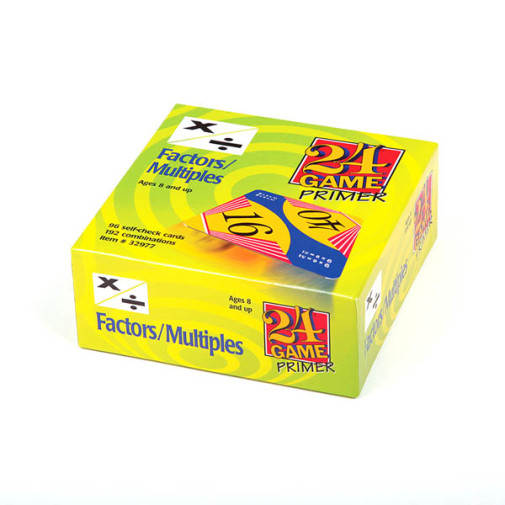We use cookies to make your experience better. To comply with the new e-Privacy directive, we need to ask for your consent to set the cookies. Learn more.
24 Game 96-Card Deck: Factors/Multiples
Factors/Multiples
Here they are, "back" in our catalog! For all those parents who would like more practice with equations but can't quite fit it in, here's an easy alternative. In 24 Games, students already have the answer - they just have to figure out the question. Each set consists of 96 double-sided 4 x 4 inch cards with 192 combinations for plenty of practice.
In the games 'Single Digits' and 'Double Digits,' there are 3 levels of play - easy, medium, and tough. The object is to use the numbers printed on the number wheel of each card only one time with the functions of add, subtract, multiply, or divide to equal the total number of 24. Hence the name of the game!
Two number wheels are printed on each card of 'Add/Subtract' and 'Multiply/Divide.' A target number is printed in white and you are to pick the wheel that can make the target number; only one wheel will work. You can add, subtract, multiply, or divide to arrive at the target number. You must use all numbers on a wheel but each number only once. Easy and medium target numbers are 3-10 and the target number for all tough cards is 24. The solution to the problem is given on the reverse side of the card.
The 'Factors/Multiples' game is played a bit differently. Each card shows two numbers, and the object is to find a common factor for those numbers. The player then states the multiplication facts. There is a self-check feature that shows correct solutions for the reverse side of the card. A fun expansion activity for groups suggests connecting the cards with common factors to create a pattern or placing four cards together to create a wheel of numbers that share a common factor.
These card games are used in classrooms around the country and have even been found to improve math scores. This is one of those games that the more you play, the faster you become. Go ahead and grow your math speed and skills while having some fun. ~ Donna
| Product Format: | Card Deck |
|---|---|
| Brand: | Suntex International |
| Grades: | 3-6 |
| EAN/UPC: | 020029329777 |
| Length in Inches: | 5 |
| Width in Inches: | 5 |
| Height in Inches: | 2.5 |
| Weight in Pounds: | 1 |

